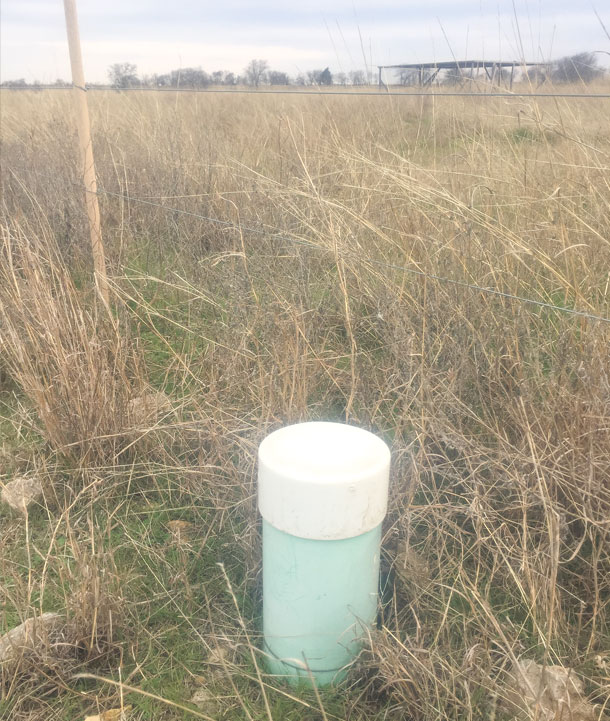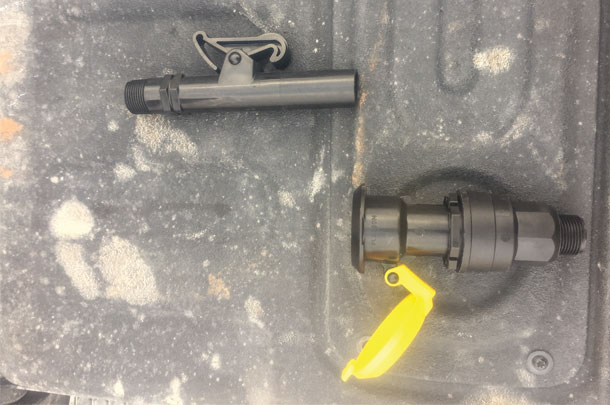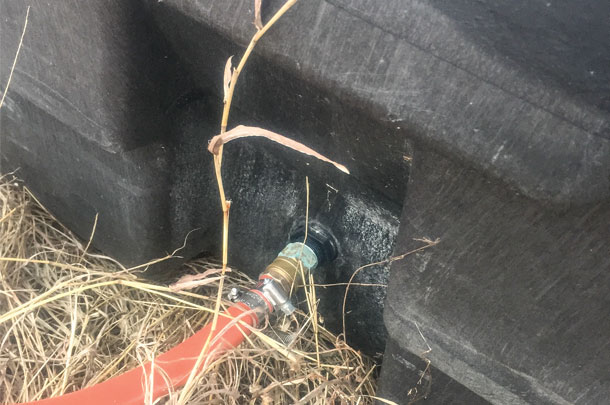In some situations, permanent watering systems can work, but in other conditions, it’s more practical to use portable water tanks. A simple over-the-ground system can work during summer, when it’s not vulnerable to freezing.

Ian Gerrish of Cobb Creek Farm in Hillsboro, Texas, has cattle and also partners in a fence and water system business. Many producers don’t want the expense of putting in a permanent system on leased farms or ranches. A portable system can be taken to your next place or moved from one paddock system to another.
“In these situations, you could use HDPE [high-density polyethylene] roll pipe,” Gerrish says.
It can be rolled onto a reel and unrolled somewhere else. “Cable companies often have leftover spindle reels. Those are what I use to roll up my pipe. You can roll a spindle over the pipe and gather it that way, but I made plates for my bale unroller on my tractor, so I just hook into it and pick it up with the tractor to move it around,” he says.
“There are several types of fittings. FloPlast makes fittings you tighten with a wrench, or you can use barbed fittings with hose clamps. When using hose clamps, always use two and go opposite ways with them so the fitting won’t come loose. That’s a tip I learned the hard way,” he says.
“With above-ground lines, make sure water doesn’t get too hot. On our farm, we have one over-ground line. Cattle readily drink warm water up to 100 degrees, but if it gets hotter than that, they won’t drink it,” he explains. A black roll pipe lying in the sun is hotter than the ambient temperature.
“My favorite things to use on any system include Rubbermaid tanks and Apex extra-flow valves that go through the tank. These three-quarter-inch valves accommodate from 4 to 175 pounds of pressure. These are worry-free and provide lots of flow if you have it. One long-tail valve can go right through the side of a Rubbermaid tank,” says Gerrish.
These tanks are very durable, whereas some of the cheaper imitations may wilt in the sun or collapse after a while. You want a tank that will withstand heat or cold weather and not break.
“Size the tank to your herd. I use the 300- and 150-gallon tanks a lot. They are enough that one person can pick it up and put it on the back of an ATV when it’s empty,” he explains.
Some people use portable tanks on a permanent system. “My fence and water company puts in a lot of rotational grazing systems. We often use a PVC or HDPE pipe and run it along an existing fence where we can set the risers out of the way of cattle and use a quick-coupler valve or a hydrant.
You can cut into the line wherever you need to and move your portable tank to each new location,” says Gerrish.

He likes plenty of hookups – the closer the better. “Most of mine are set 200 feet apart. A little added cost for quick-couplers (under $20 apiece for each additional riser) gives more flexibility for where you can put tanks if you are doing high-density grazing and move cattle often. Just make sure those valves are protected so cattle don’t walk on them/rub them and break them off.”
Innovations on a Texas ranch
Emry Birdwell and his wife, Deborah, run stocker cattle on their ranch near Henrietta, Texas. The cattle graze intensively, moved several times a day to new pasture. In the past 12 years, they increased stocking capacity on their ranch from 2,400 head to more than double that number.
“Today, we have 120 permanent paddocks, fenced with electric hard wire, and divide each of those three to five ways with poly wire. During March through June, we move cattle on average about four times per day,” says Birdwell.
“In 2011, we started putting in a pipeline system. We’d been watering in dirt tanks that collect runoff from rainwater. Due to lack of rain, we put in the pipeline so we can pump from dirt tanks into water troughs,” he says.
Four years ago, he made a mobile water trough, pump and generator. These are on a trailer and can be moved from one water hole to another. “This enables us to pump from a water source we couldn’t use into a trough and make it usable. This stretches the water supply further. We can water about 4,000 cattle out of one trough,” he says.

The portable trough is a big propane tank cut in half; it is 24 feet long, 5 feet wide and holds about 1,500 gallons, mounted on dual wheels. “This trough waters about 30 cattle at a time, and they can keep coming and drinking,” he says. The pipeline has good flow and keeps up with the cattle.
“We use this trough on a pressurized line and can also pump directly from any water source. When it’s hooked to the pressurized line, we have three floats for maximum water flow. We also have a pump and generator sitting on the trailer so we can pull it up to a fenced-off dirt tank to pump continually into the trough.
An overflow outlet from the trough runs any extra water back into the dirt tank.” Drains enable them to empty the trough quickly when it’s time to move it.
“When we move the trough, it takes about five minutes to drain; we just disconnect the hoses, chain them to the trough and drive off. We can pull the empty trough-trailer with an ATV.” He put five jacks on it so he can level the trough anywhere, no matter what the terrain.
He now has a second portable trough so he can have one already set up in the new pasture when cattle are moved. This innovation helped stretch water supplies during the drought and is helpful even under normal conditions.
“Where we now have water lines across the pastures, with valves, we can run water to different areas where we’ve never had water – for more uniform utilization and trampling – instead of always having water in the same spot. In years past, we’d run out of water before we ran out of grass. We eliminated that problem with portable troughs,” says Birdwell.
He is burying the poly pipe. “It is very durable; cattle can’t hurt it walking on it, and it won’t burst if water froze. We could get by leaving it on top of the ground, but this part of the country is prone to fire, and the pipe would burn up. We want it protected by being underground,” he explains. ![]()
PHOTO 1: A portable water trough made by Emry Birdwell in Henrietta, Texas. Photo provided by Emry Birdwell.
PHOTO 2: Another photo shows the Plasson female quick-coupler inside a 6-inch sewer pipe on a permanent system. “On my portable systems, I try to roll out my HDPE pipe alongside an existing fence and cut in my valve locations so they end up next to a post that I can tie them to for protection. Putting the hose and valves on the opposite side of a temporary electric fence is also a good option.” —Ian Gerrish
PHOTO 3: This photo shows the Plasson quick-coupler valve that Ian uses for his permanent and portable water systems. As with the Apex valve, the male part of the coupler is pipe-threaded so a hose thread to pipe-thread fitting is a good addition.
PHOTO 4: A garden hose hookup to the back of the Apex valve. While the garden hose will attach directly to the back of the valve generally without issue, the valve is pipe-threaded, so using a female-to-female hose thread to pipe thread coupler ensures a good seal and longer life for your tank setup. Photos provided by Ian Gerrish.

-
Heather Smith Thomas
- Freelance Writer
- Salmon, Idaho
- Email Heather Smith Thomas









